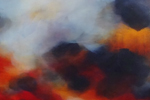Summer 2016: Prose
Let Me Explain
Nonfiction by Carisa Miller
“Mommy! I’m peeing out of my anus!” my freshly potty-trained toddler proudly announced from the toilet.
Anatomy is tricky. And it’s comically misidentified body parts like this that makes it a fun subject to engage in with my two daughters, currently ages four and six. I also talk with them about death, and puberty, homelessness, war, religion, human rights, the environment, consumerism, and government spending.
I once outlined the hereditary aspects of alcoholism on the twenty minute drive to summer camp.
In the home I grew up in, The Facts of Life was just a TV show with a catchy theme song. Sex did not exist. Roadkill was just sleeping.
Around the time my youngest began experimenting with putting things in light sockets, a neighborhood squirrel fried himself on the utility pole across the street. My daughter and I were nestled on the couch reading in front of the living room window when the transformer blew with a boom that jumped us out of our skin; we looked up to see a single firework exploding in full view, white sparks showering to the ground.
We found old Fluffy Britches face down in the dirt at the base of the pole with two holes burned clean through his belly. “Should we bury him or let that crow over there eat him for lunch?” I asked my daughter. At age three, animal death was old hat for her. She’d already rescue-murdered countless insects, lost a pet fish and discovered a dead mouse and a half in the driveway, likely remnants of the neighbor cat’s interrupted midnight snack. My daughter elected to bury the squirrel and promised this time not to dig it back up, like with the fish. The occasion earned me additional circle-of-life credits plus high-voltage-warning bonus points. After that day, all I had to do was yell, “DEAD SQUIRREL!” any time my daughter went near an electrical outlet and she’d fall all over herself trying to get away from it.
When my mom’s cat was killed by the neighbor dog, she didn’t want my girls to know what had happened for fear the truth would upset them. It didn’t. By the time I had talked them through it, my children had a decent layman's understanding of the domestication of wolves and the latent predatory instincts of today’s canine companions.
Life offers so much educational fodder! I also find that leaving National Geographic magazines in the bathroom generates a unique curriculum. I can’t count on elephant poaching to come up otherwise.
But most of my elucidations are prompted by everyday questions from my daughters, such as: “Why is that man standing on the corner with a sign?” and “What’s for dinner?”
In case my children were vegetarians, but couldn't tell me because they were toddlers, I thought it would be considerate to let them know when I was feeding them animals. I’d want someone to tell me that the lamb on my plate is the body of the same kind of animal we fed from a bottle on our farm-stay vacation, even if it means that every time I serve meat, I get the Portlandia-degree. “Which animal is this, Mommy? Tell us the story of how it got to be our dinner. Did you kill it?”
The path of explanation sometimes leads to me hanging my head at the dinner table, wondering why I didn’t just leave well-enough alone, while my husband sits across from me nearly shaking his head clean-off.
My kids are at that tender age when the way new information affects them is based mostly on how it is presented to them. How I present it to them. I am acutely aware that my responsibility in this role, as my children’s model and teacher, runs the full spectrum: from the great matter of their self-esteem to the trivial matter of their position on arachnids. They wouldn’t gently return wayward spiders to the garden if I screamed every time I saw one in the house.
Our lives—the course, characteristics, and quality of—depend on how we relate to the world. I don’t want my daughters to buckle under the weight of it loaded upon them all at once when they’re “old enough”—like I did, the ugly parts curling me into a ball, petrified inside my first apartment. I want us to talk about as much as possible, as soon as possible, before their teen years turn off their ears.
Besides, breaking topics down to an elementary level of understanding gives me continued practice accepting harsh truths and being okay with words like “vulva.” In a line graph depicting the topics I’ve broached with my girls, an extreme peak would mark the correlation between my level of discomfort with a subject and my not-ever-shutting-up about it.
It may come as a surprise to learn then, that I haven’t yet talked to my children about sex.
I expected to when my oldest and I stood over the toilet looking down at my used tampon. When I said, “Each month, when there is no baby growing inside, a woman’s uterus sheds its nutrient-rich blood lining,” I thought it would lead to, “But, Mama, what happens when there is a baby growing inside?” and, “How does it get there?” But no. Likewise, when I got specific about our Golden Retriever’s impending spay surgery and tossed in an offhand comment about indiscriminate mating, I anticipated her request for the definition of mating. Still no.
I’m betting it will be her little sister who first asks how babies are made, but first she’ll need a refresher course in reproductive anatomy. When we were in the bath together recently, her hand grazed my crotch and she said, “Mommy, I just touched your penis.”
And I said, “I’m pretty sure you didn’t.”
We have so much to learn.
| |

|

|
 |
 |
 |
 |
|||
|
A sampling of the powerful female creative force thriving in our region. |
Six women dazzle us with both their honesty and humor. |
Four artists use layering and process as metaphors for life beyond art. |
Meet the fabulous women behind the voices and visions of our ninth issue. |

